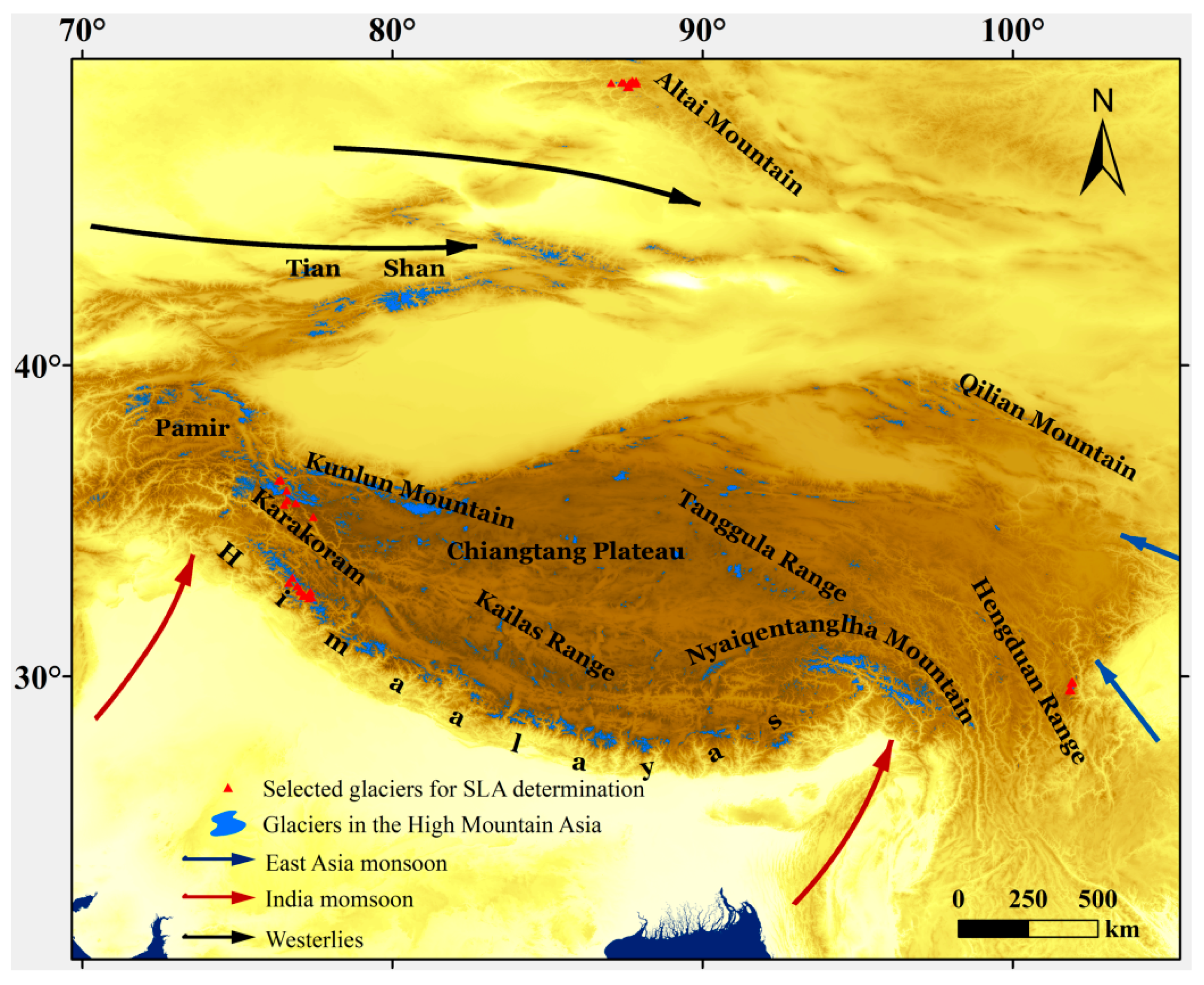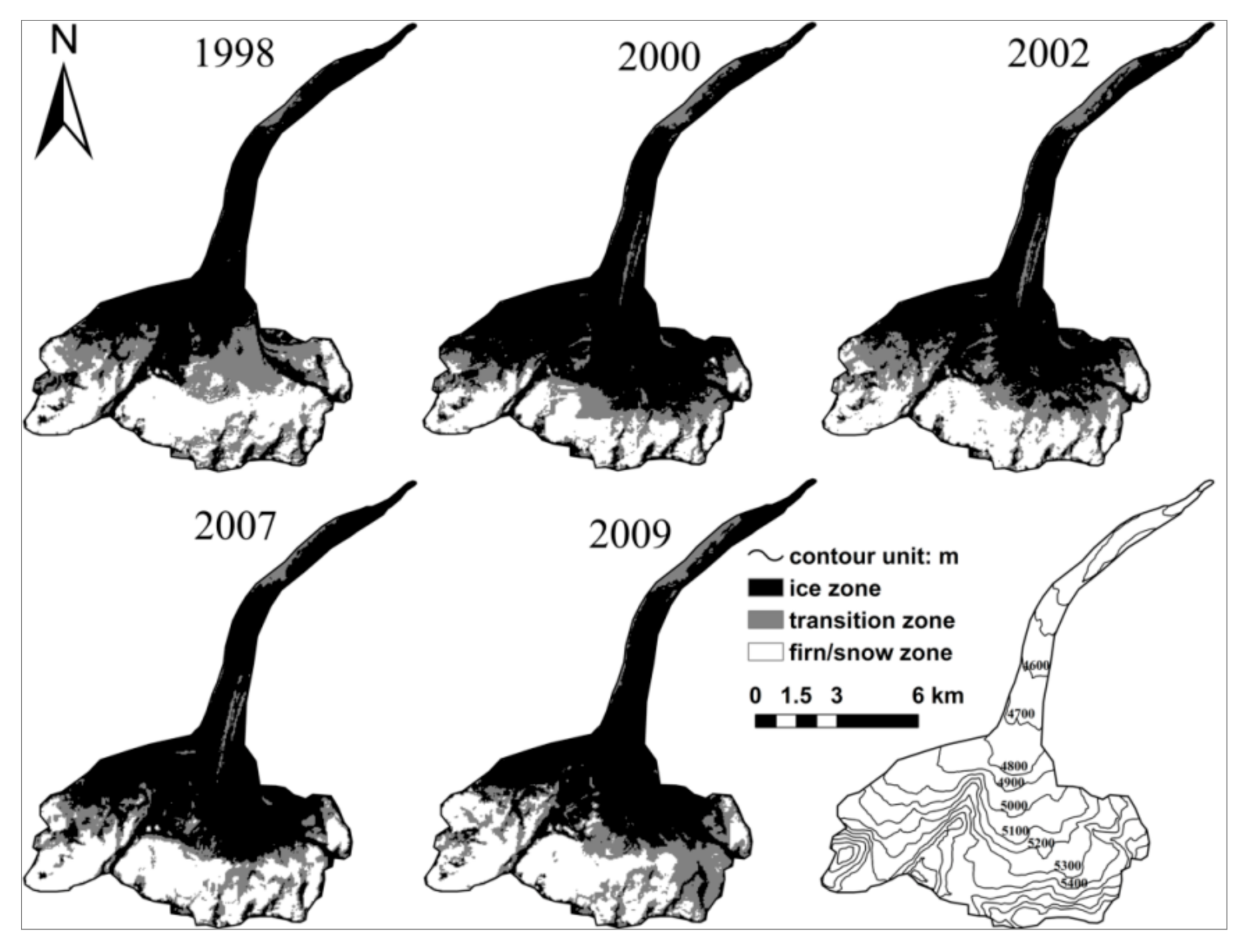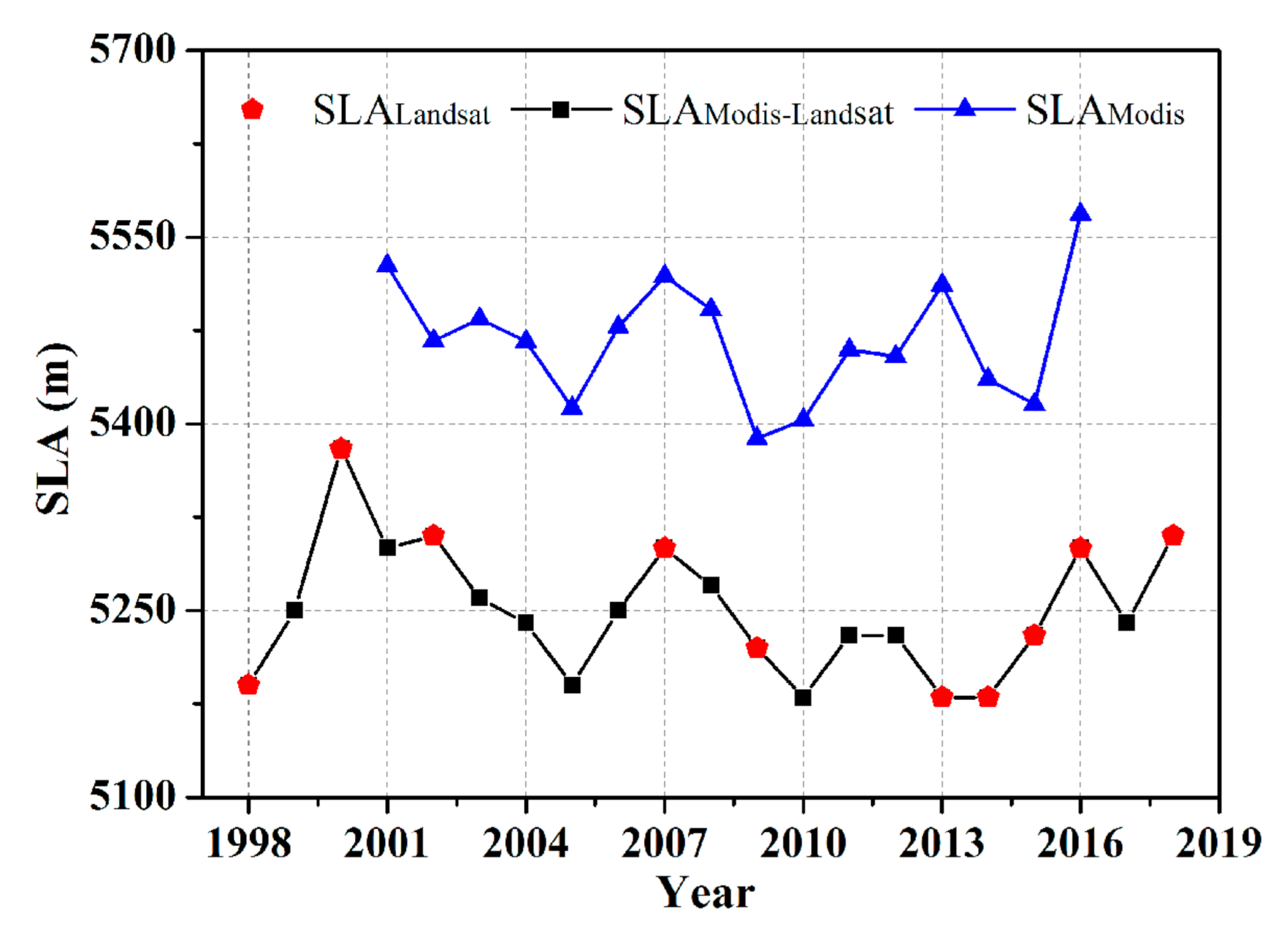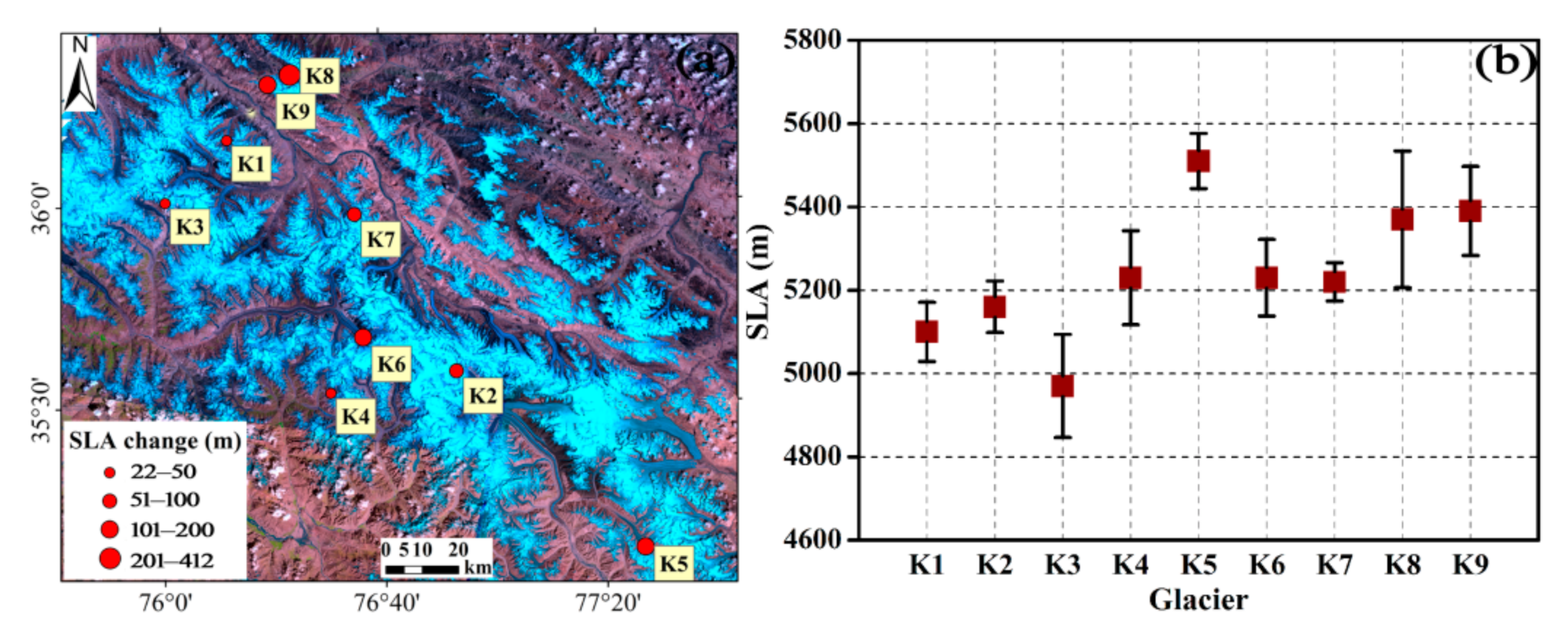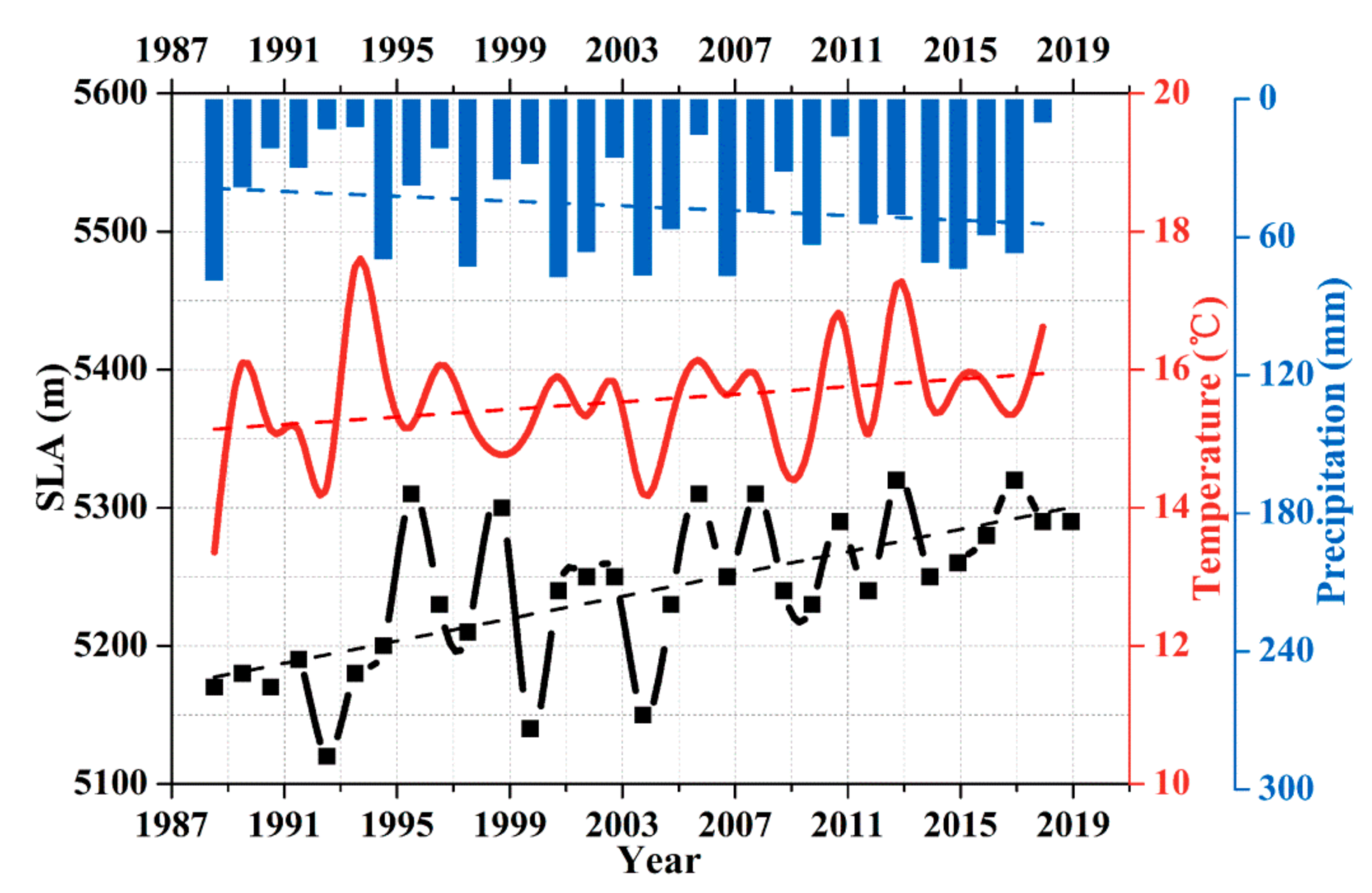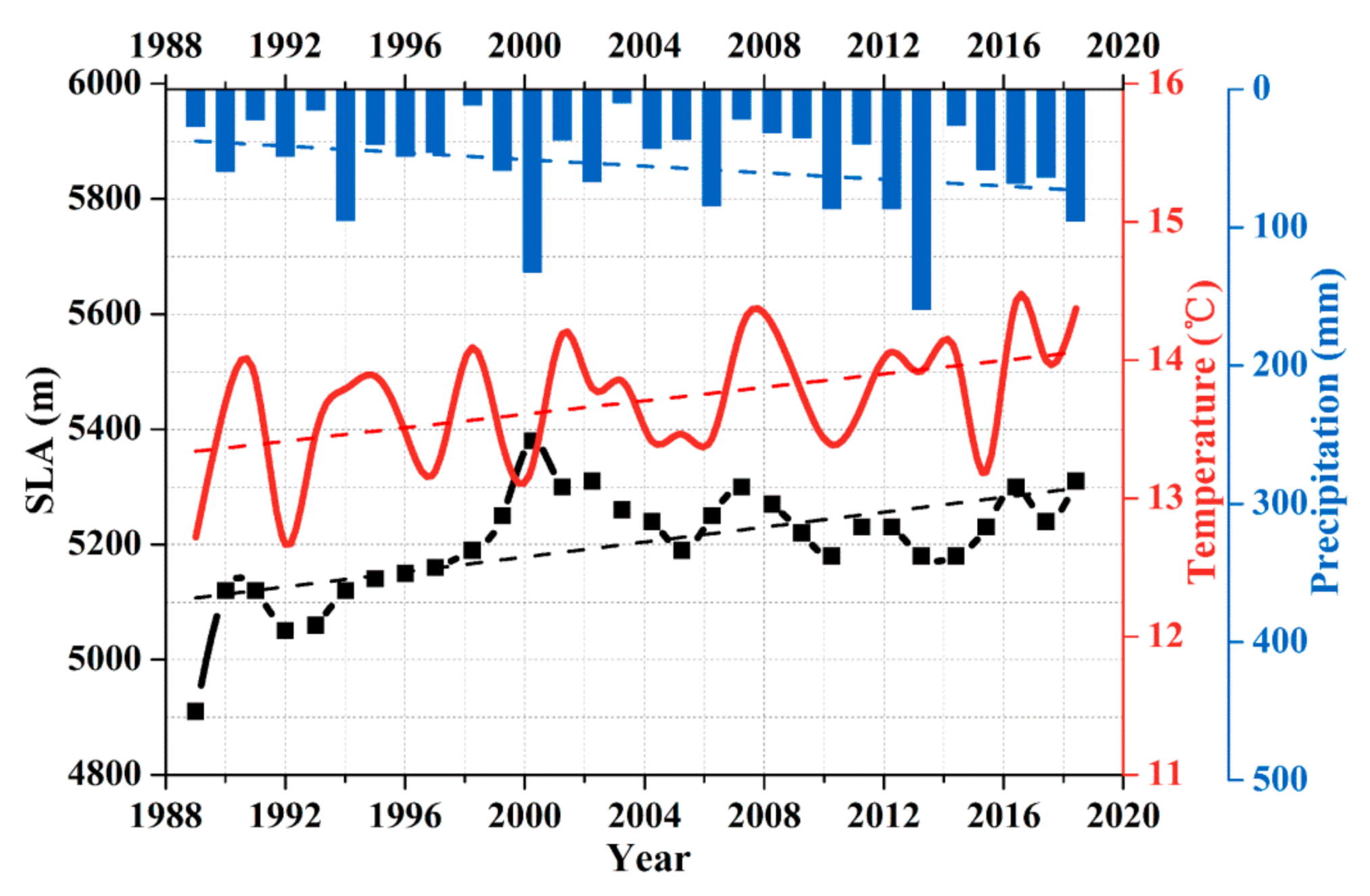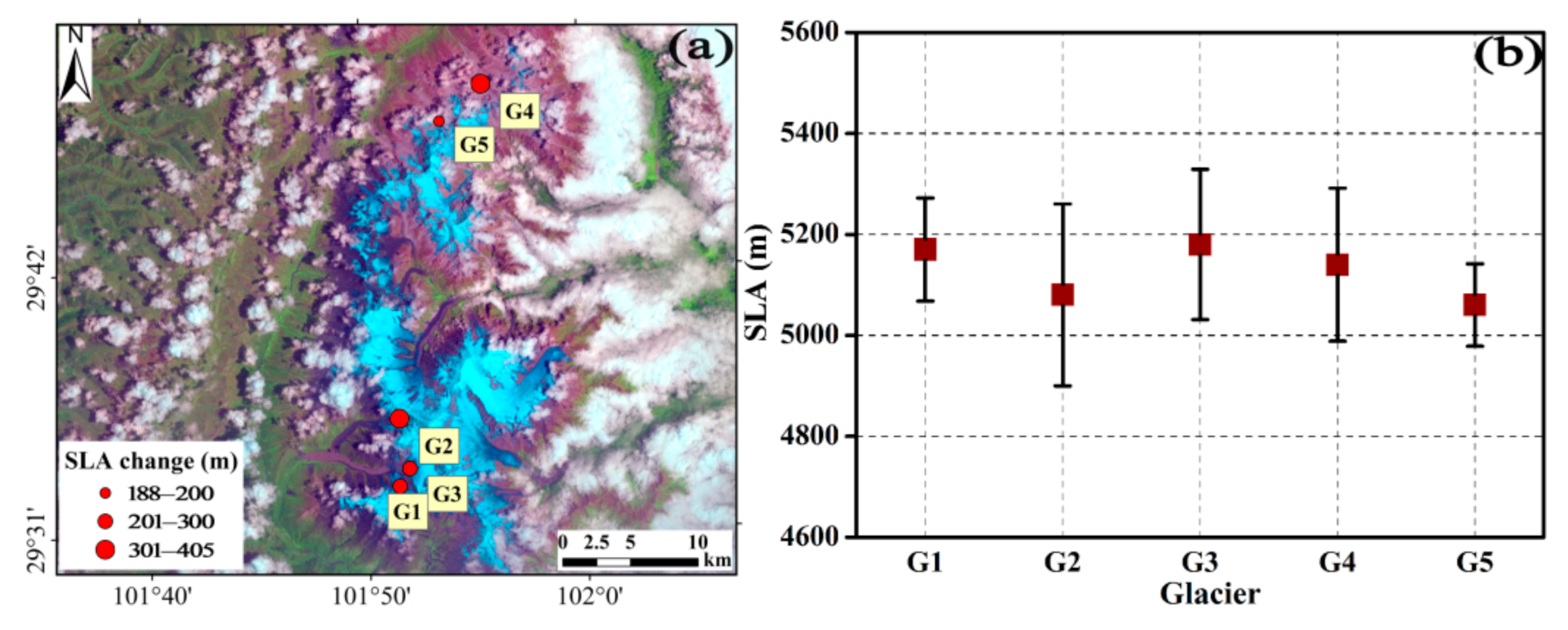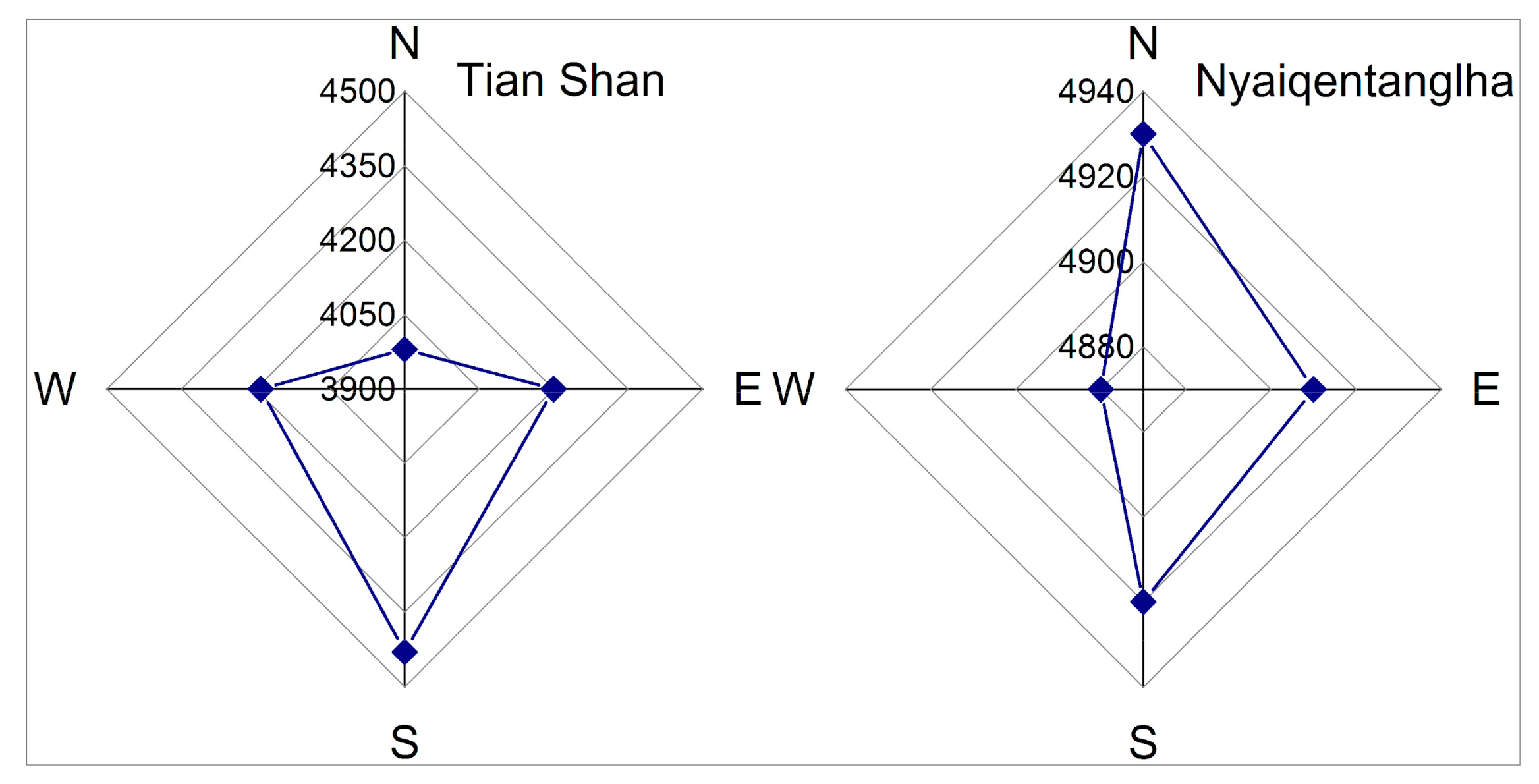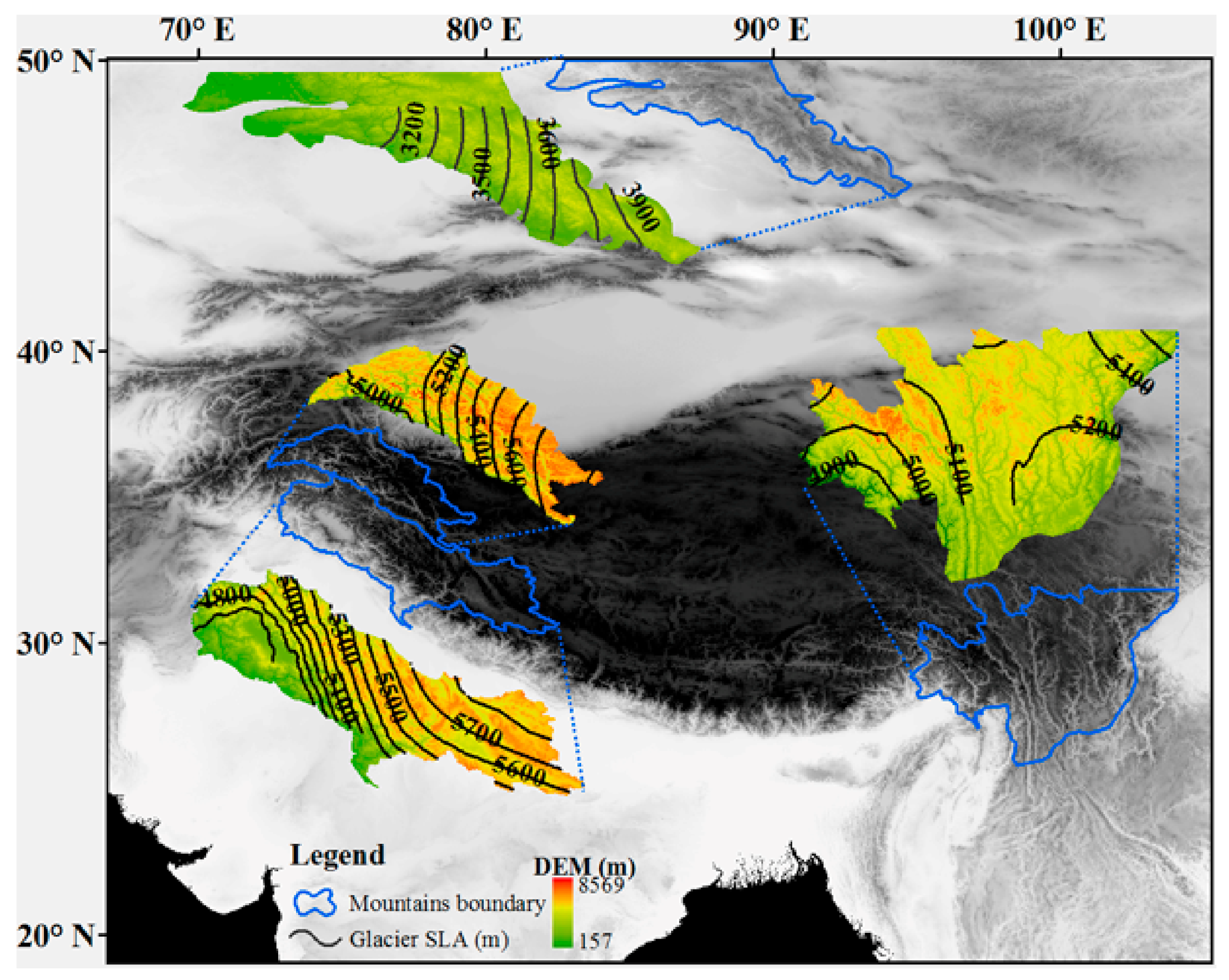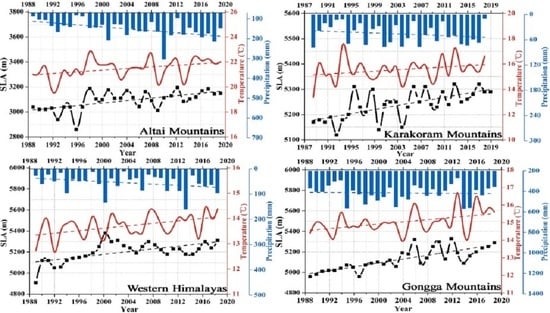3.1. Data
Landsat Multispectral Scanner System (MSS)/Thematic Mapper ™/Enhanced Thematic Mapper Plus (ETM+)/Operational Land Imager (OLI) data were downloaded from the USGS (
http://earthexplorer.usgs.gov/) and the Geospatial Data Cloud (
http://www.gscloud.cn). According to the three criteria for image selection, Landsat images of the Altai Mountains, the Karakoram Mountains, the Himalayas, and the Gongga Mountain from 1989 to 2019 were screened (
Table 1).
Landsat data have a high spatial resolution (30 m) and long time series, making them an ideal remote-sensing dataset for mapping glacier SLA. High Mountain Asia glaciers have a long melt season (generally the June–August timeframe), such that the highest SLA may occur on any day in either July or August (occasionally in early September). However, the data used in this study may not capture the highest SLA due to the large number of sensors and relatively low temporal resolution (8–16 days) of the Landsat satellites, which introduces a degree of uncertainty in the extracted SLA. Here we limit our data range for determining the glacier SLA to remote-sensing images that were acquired between 7 July and 15 September during the 1989–2019 period. Approximately 75% of the Landsat scenes that were analyzed for glacier SLA extraction were acquired in August (
Figure 2).
Sentinel-2 data were used to evaluate the uncertainty in the Landsat-derived glacier SLA that arose from inconsistent Landsat data acquisition times since Sentinel-2 images possess a considerably higher spatiotemporal resolution. Sentinel 2A and 2B were launched in June 2015 and March 2017, respectively. Both satellites have a maximum spatial resolution of 10 m, and a temporal resolution to 5 days is achieved when Sentinel 2A and 2B data are analyzed together. We selected Sentinel-2 data that spanned the May 1–October 31, 2018 period for our analysis. Furthermore, the temporal proximity of the Sentinel-2 data to the Landsat data provides the opportunity to construct a long-term time series of glacier SLA from these two datasets.
Moderate Resolution Imaging Spectroradiometer (MODIS) data, which possess a high temporal resolution, were used to interpolate the glacier SLA where it was not extracted from the Landsat scenes. We preprocessed the MOD10A data to extract the glacier SLA [
30], and then used Landsat data as the “true values” to verify the MODIS-derived glacier SLA, and obtain the annual snowline positions. We used the Shuttle Radar Topography Mission (SRTM) digital elevation model (DEM) (
http://earthexplorer.usgs.gov/) to determine the snowline position on each analyzed glacier; the horizontal and vertical accuracies of the DEM are
and
, respectively.
There are two main functions of the meteorological data in this study. The first is to evaluate the Landsat-derived SLA uncertainty using Sentinel 2 data. Temperature and precipitation data were also acquired from Tuole weather station, which is near Qiyi Glacier in the Qilian Mountains. The second function is to discuss the effects of temperature and precipitation on glacier SLA across High Mountain Asia. We acquired data from the nearest meteorological stations to the analyzed glacier areas during the 1998–2019 period; detailed information on the nearest meteorological stations in our study area is provided in
Table 2. The analyzed glacier regions, with the exception of the Altai Mountains, mainly experience summer accumulation and melt, such that the average summer (June–August) temperature and precipitation were mainly collected for the analysis. We acquired summer precipitation and cold season (September–May) precipitation for the Altai Mountains since this region mainly experiences summer melt and cold season accumulation.
3.2. Methods
Data processing methods included data screening, pre-processing and SLA determination. Data screening mainly followed three criteria or principles: Landsat TM/ETM+/LC 8 images with (1) little cloud cover, (2) no recent snowfall on the glaciers, and (3) at the end of the summer melt season (July–August) were preferentially selected to enhance the probability of extracting the highest snowline or minimum snow cover. Image pre-processing included radiometric calibration, registration, atmospheric correction, and narrow-band to broadband albedo conversion. The subsequent delineation of the SLA was based on the registered DEM.
Radiation calibration is the process of converting a digital number (
DN) to a corresponding radiation. The radiation of Landsat Level 1 product was calculated using the following equation:
where
Lλ is TOA spectral radiance [W (m
−2·sr
−1·μm
−1)],
ML is band-specific gain from the metadata;
Qcal is quantized and calibrated standard product pixel values; and
AL is band-specific bias from the metadata.
Image registration is the process of matching and superposing two or more images acquired at different times, by different sensors (imaging devices) or under different conditions (i.e., weather, illumination, camera position and angle). In this study, Landsat image (ID: LT514402619980826, mean cloud cover: 4.57%) was taken as the base image to calibrate other Landsat images. The registered Landsat data was used as a base image to register the DEM data. This study utilized the ENVI software’s automatic accurate registration function, which makes the root mean square error (RMSE) of the ground control points less than 1, and performs quadratic polynomial correction to ensure registration accuracy and eventually obtains images with high registration quality.
Atmospheric correction can been used to reduce or eliminate the effect of atmospheric water vapor on the sensor, and can further calculate the narrowband albedo of the image. The FLAASH (Fast Line-of-sight Atmospheric Analysis of Spectral Hypercubes) module based on Modtran 4+ radiation transfer code was adopted in this study. This model can quickly perform atmospheric corrections of multispectral, hyperspectral data and aerial images, which could effectively eliminate the influence of atmosphere and light on the reflection of objects. The equation can be written as:
where
L is the surface radiance [W (m
−2·sr
−1·μm
−1)];
ρ is the pixel surface reflectance;
ρe is the mean surface reflectance of the pixel and its surrounding regions;
S is the spherical albedo of the atmosphere;
La is the backscattering radiation of the atmosphere; and A, B is the coefficient which is related to the atmospheric and geometric conditions, but not to the underlying surface.
Our study determined the boundary between snow and bare ice based on the difference of their albedo. However, the albedo has not been directly obtained from satellites observations. Signals received by satellite sensors originate from radiances constitute radiation from a particular direction in narrowband at the top of the atmosphere. These signals must be converted to surface albedo. Based on near-surface and aircraft measurements, Greuell [
31] established a narrowband-to-broadband albedo conversion model for glacier ice and snow, and it has a residual standard deviation of 0.011 for Landsat images. The equation is as follows:
where
α is the albedo;
ρ is the narrowband albedo;
i and
j represent the specific band. For Landsat MSS,
i and
j represent the 1st and 3rd bands, respectively. For Landsat TM/ETM+,
I and
j represent the 2nd and 4th bands, respectively, because Landsat OLI has been changed in the band setting (a band is added in the visible band), and
i and
j represent the 3rd and 5th bands, respectively.
In order to calculate broadband albedo, the downloaded level-1C Sentinel 2 data need to conduct atmospheric correction. We will convert top-of-atmosphere reflectance of Level 1C Sentinel 2 data to surface reflectance data using the Sen2cor software. Sen2cor can be found on
http://step.esa.int/main/third-party-plugins-2/sen2cor/. The atmospherically corrected Sentinel 2 data (Level 2A) were resembled using SNAP software and then converted to ENVI format for output. A narrow-to-broadband conversion was then performed through ENVI software to obtain the broadband albedo [
32,
33]. Snow line locations were determined based on the difference of albedo between the ice and snow. The snow line locations were extracted in the same way as the Landat data. In this case, the broadband albedo is obtained by the following equation,
where
α is the albedo;
ρ is the narrowband albedo; 2, 4, 8, 11, and 12 represent the specific band of Sentinel 2.
Based on the registered DEM data, its contour layer was extracted and overlaid with the broadband albedo image, and then the glacier surface was classified according to the difference between snow and bare ice albedo by ArcGIS software. If there was no transition zone between snow and bare ice, the boundary between snow and bare ice was defined as a snowline; if a transition zone existed, the boundary between snow and the transition zone was defined as a snowline. The SLA was then determined by the DEM contour layer by linking the lower edges of snowlines. It is possible that a snowline crosses several contours and does not coincide with a contour; in this case, the mean contour near the snowline was considered as the SLA [
15,
19] (
Figure 3).
There are fewer available Landsat scenes for assessing the glacier SLA uncertainty over different dates in a given period due to the temporal resolution of the Landsat images and the impacts of clouds and new snowfall. We therefore combined the Sentinel-2 data, which possess a high temporal resolution (five days when using the data from 2A and 2B). Similarly, the Landsat temporal resolution, cloud cover, fresh snowfall, and stripe of the Landsat ETM data, all of which may result in missing data, could affect the glacier SLA time series reconstruction and analysis of glacier SLA variability over time. In particular, the glacier SLA in a given single year may determine the linear trend of the entire SLA, making it critical to have a complete SLA time series. MODIS data have a high temporal resolution (1 day) and long time series (data acquisition since 2000), but they possess a low spatial resolution (≤500 m); we therefore used the Landsat-derived SLAs as the “true values” to correct the MODIS-derived SLAs and further interpolate the Landsat-derived SLA time series (
Figure 4).
